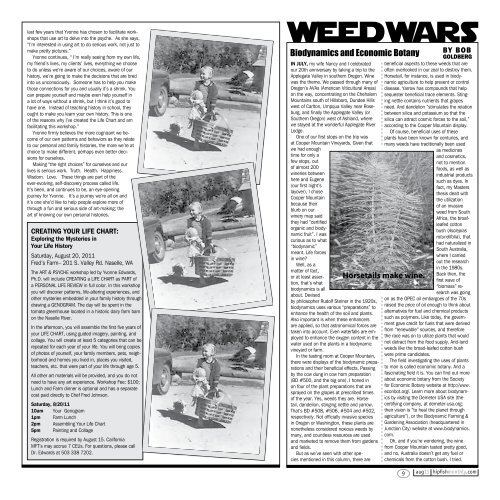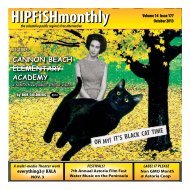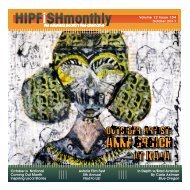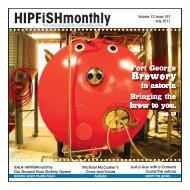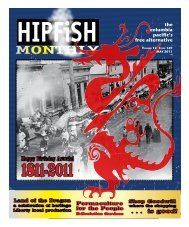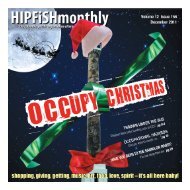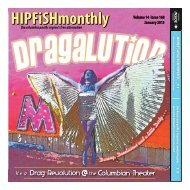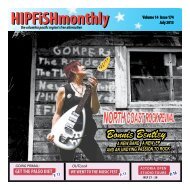Medical Spa LaCost - HIPFiSHmonthly
Medical Spa LaCost - HIPFiSHmonthly
Medical Spa LaCost - HIPFiSHmonthly
You also want an ePaper? Increase the reach of your titles
YUMPU automatically turns print PDFs into web optimized ePapers that Google loves.
last few years that Yvonne has chosen to facilitate workshops<br />
that use art to delve into the psyche. As she says,<br />
“I’m interested in using art to do serious work, not just to<br />
make pretty pictures.”<br />
Yvonne continues, “ I’m really seeing from my own life,<br />
my friend’s lives, my clients’ lives, everything we choose<br />
to do unless we’re aware of our choices, aware of our<br />
history, we’re going to make the decisions that are bred<br />
into us unconsciously. Someone has to help you make<br />
those connections for you and usually it’s a shrink. You<br />
can prepare yourself and maybe even help yourself in<br />
a lot of ways without a shrink, but I think it’s good to<br />
have one. Instead of teaching history in school, they<br />
ought to make you learn your own history. This is one<br />
of the reasons why I’ve created the Life Chart and am<br />
facilitating this workshop.”<br />
Yvonne firmly believes the more cognizant we become<br />
of our own patterns and behaviors as they relate<br />
to our personal and family histories, the more we’re at<br />
choice to make different, perhaps even better decisions<br />
for ourselves.<br />
Making “the right choices” for ourselves and our<br />
lives is serious work. Truth. Health. Happiness.<br />
Wisdom. Love. These things are part of the<br />
ever-evolving, self-discovery process called life.<br />
It’s been, and continues to be, an eye-opening<br />
journey for Yvonne. It’s a journey we’re all on and<br />
it’s one she’d like to help people explore more of<br />
through a fun and serious side of art-making; the<br />
art of knowing our own personal histories.<br />
CREATING YOUR LIFE CHART:<br />
Exploring the Mysteries in<br />
Your Life History<br />
Saturday, August 20, 2011<br />
Fred’s Farm– 201 S. Valley Rd. Naselle, WA<br />
The ART & PSYCHE workshop led by Yvonne Edwards,<br />
Ph.D. will include CREATING a LIFE CHART as PART of<br />
a PERSONAL LIFE REVIEW in full color. In this workshop<br />
you will discover patterns, life-altering experiences, and<br />
other mysteries embedded in your family history through<br />
drawing a GENOGRAM. The day will be spent in the<br />
tomato greenhouse located in a historic dairy farm barn<br />
on the Naselle River.<br />
In the afternoon, you will assemble the first five years of<br />
your LIFE CHART, using guided imagery, painting, and<br />
collage. You will create at least 5 categories that can be<br />
repeated for each year of your life. You will bring copies<br />
of photos of yourself, your family members, pets, neighborhood<br />
and homes you lived in, places you visited,<br />
teachers, etc. that were part of your life through age 5.<br />
All other art materials will be provided, and you do not<br />
need to have any art experience. Workshop Fee: $100;<br />
Lunch and Farm dinner is optional and has a separate<br />
cost paid directly to Chef Fred Johnson.<br />
Saturday, 8/20/11<br />
10am Your Genogram<br />
1pm Farm Lunch<br />
2pm Assembling Your Life Chart<br />
5pm Painting and Collage<br />
Registration is required by August 15. California<br />
MFT’s may accrue 7 CEUs. For questions, please call<br />
Dr. Edwards at 503 338 7202.<br />
Biodynamics and Economic Botany<br />
In July, my wife Nancy and I celebrated<br />
our 20th anniversary by taking a trip to the<br />
Applegate Valley in southern Oregon. Wine<br />
was the theme. We passed through many of<br />
Oregon’s AVAs (American Viticultural Areas)<br />
on the way, concentrating on the Chehalem<br />
Mountains south of Hillsboro, Dundee Hills<br />
west of Carlton, Umpqua Valley near Roseburg,<br />
and finally the Applegate Valley (or<br />
Southern Oregon) west of Ashland, where<br />
we stayed at the wonderful Applegate River<br />
Lodge.<br />
One of our first stops on the trip was<br />
at Cooper Mountain Vineyards. Given that<br />
we had enough<br />
time for only a<br />
few stops, out<br />
of almost 200<br />
wineries between<br />
here and Eugene<br />
(our first night’s<br />
layover), I chose<br />
Cooper Mountain<br />
because their<br />
blurb on our<br />
winery map said<br />
they had “certified<br />
organic and biodynamic<br />
fruit”. I was<br />
curious as to what<br />
“biodynamic”<br />
meant. Life forces<br />
in wine?<br />
Well, as a<br />
matter of fact,<br />
or at least assertion,<br />
that’s what<br />
biodynamics is all<br />
about. Devised<br />
by philosopher Rudolf Steiner in the 1920s,<br />
biodynamics uses various “preparations” to<br />
enhance the health of the soil and plants.<br />
Also important is when these enhancers<br />
are applied, so that astronomical forces are<br />
taken into account. Even waterfalls are employed<br />
to enhance the oxygen content in the<br />
water used on the plants in a biodynamic<br />
vineyard or farm.<br />
In the tasting room at Cooper Mountain,<br />
there were displays of the biodynamic preparations<br />
and their beneficial effects. Passing<br />
by the cow dung in cow horn preparation<br />
(BD #500, and the big one), I honed in<br />
on four of the plant preparations that are<br />
sprayed on the grapes at prescribed times<br />
of the year. Yes, weeds they are. Horsetail,<br />
dandelion, stinging nettle and yarrow.<br />
That’s BD #508, #506, #504 and #502,<br />
respectively. Not officially invasive species<br />
in Oregon or Washington, these plants are<br />
nonetheless considered noxious weeds by<br />
many, and countless resources are used<br />
and marketed to remove them from gardens<br />
and fields.<br />
But as we’ve seen with other species<br />
mentioned in this column, there are<br />
by bob<br />
goldberg<br />
beneficial aspects to these weeds that are<br />
often overlooked in our zeal to destroy them.<br />
Horsetail, for instance, is used in biodynamic<br />
agriculture to help prevent or control<br />
disease. Yarrow has compounds that help<br />
sequester beneficial trace elements. Stinging<br />
nettle contains nutrients that grapes<br />
need. And dandelion “stimulates the relation<br />
between silica and potassium so that the<br />
silica can attract cosmic forces to the soil,”<br />
according to the Cooper Mountain display.<br />
Of course, beneficial uses of these<br />
plants have been known for centuries, and<br />
many weeds have traditionally been used<br />
as medicines<br />
and cosmetics,<br />
not to mention<br />
foods, as well as<br />
industrial products<br />
such as dyes. In<br />
fact, my Masters<br />
thesis dealt with<br />
the utilization<br />
of an invasive<br />
weed from South<br />
Africa, the broafleafed<br />
cotton<br />
bush (Asclepias<br />
rotundifolia), that<br />
had naturalized in<br />
South Australia,<br />
where I carried<br />
out the research<br />
in the 1980s.<br />
Back then, the<br />
first wave of<br />
“biomass” research<br />
was going<br />
on as the OPEC oil embargoes of the 70s<br />
raised the price of oil enough to think about<br />
alternatives for fuel and chemical products<br />
such as polymers. Like today, the government<br />
gave credit for fuels that were derived<br />
from “renewable” sources, and therefore<br />
the race was on to utilize plants that would<br />
not detract from the food supply. Arid-land<br />
weeds like the broad-leafed cotton bush<br />
were prime candidates.<br />
The field investigating the uses of plants<br />
to man is called economic botany. And a<br />
fascinating field it is. You can find out more<br />
about economic botany from the Society<br />
for Economic Botany website at http://www.<br />
econbot.org/. Learn more about biodynamics<br />
by visiting the Demeter USA site (the<br />
certifying company, at demeter-usa.org;<br />
their vision is “to heal the planet through<br />
agriculture”), or the Biodynamic Farming &<br />
Gardening Association (headquartered in<br />
Junction City) website at www.biodynamics.<br />
com.<br />
Oh, and if you’re wondering, the wine<br />
from Cooper Mountain tasted pretty good,<br />
and no, Australia doesn’t get any fuel or<br />
chemicals from the cotton bush. I tried.<br />
Horsetails make wine.<br />
9 aug11 hipfishmonthly.com


